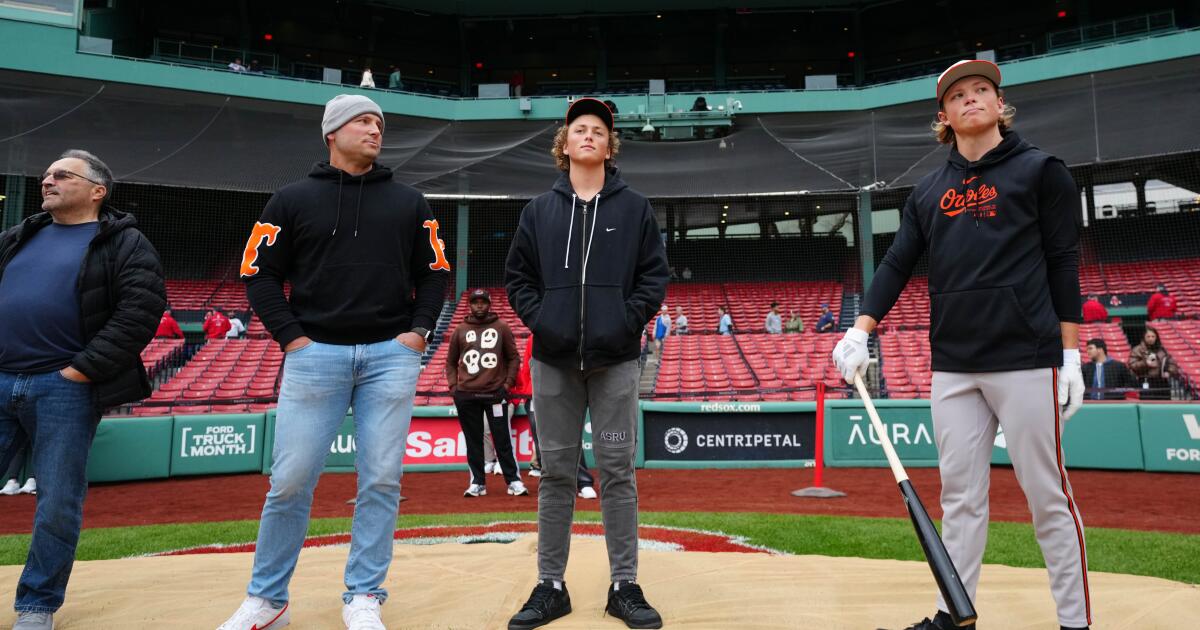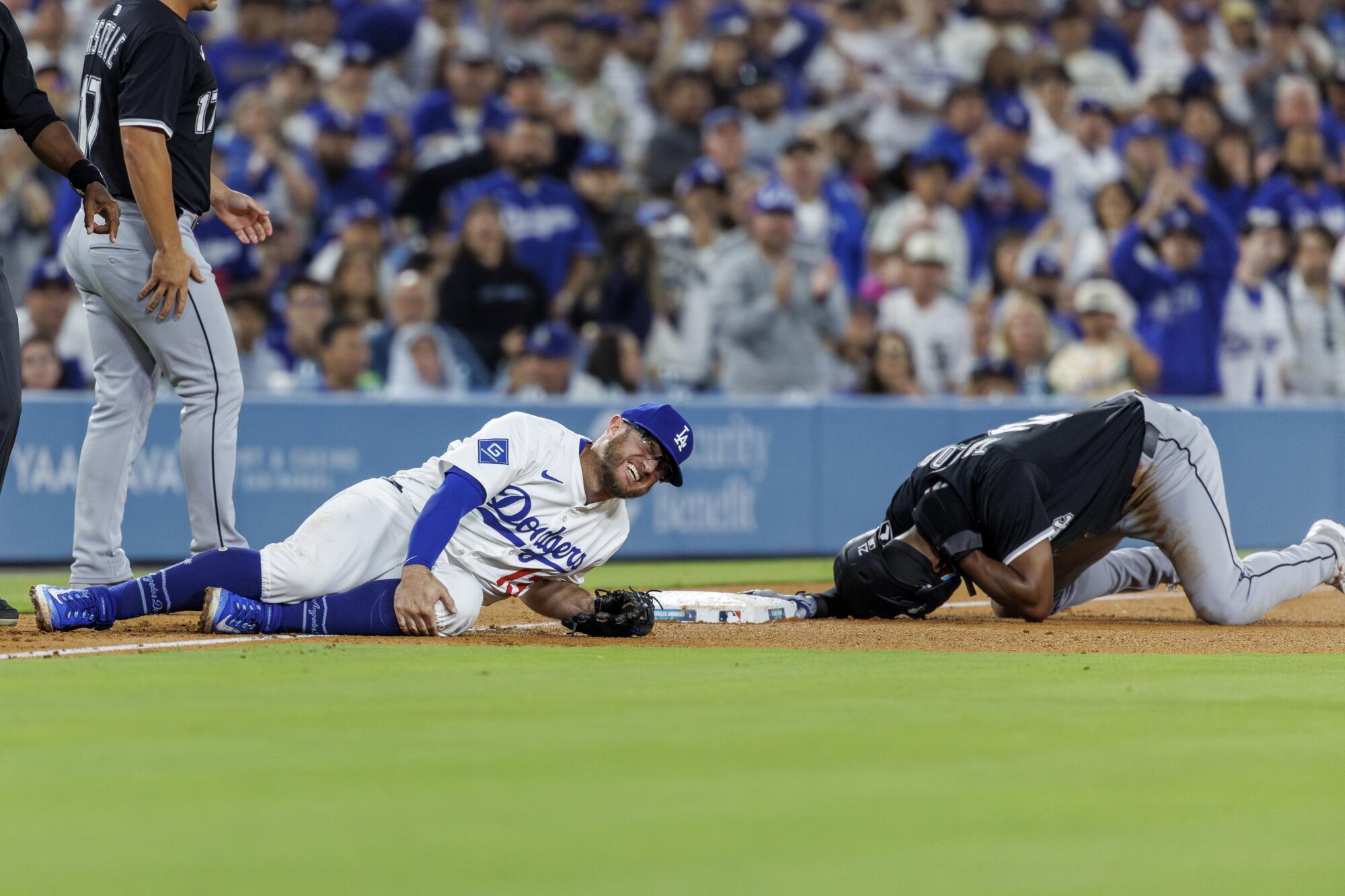Like father, like son: MLB draft prospects follow in dad’s footsteps
Before Jerry Hairston Jr. became a voice of the Dodgers, that buoyant broadcaster on Spectrum Sports Net LA putting a blue-tinged spin on pregame and postgame analysis, he was a Major League ballplayer for 16 seasons.
The name Hairston is synonymous with baseball, Jerry and his brother Scott the third generation of men whose livings were made on the diamond.
Their father, Jerry Hairston, played 14 big league seasons through the 1970s and ‘80s. Their uncle John was a ballplayer. And their grandfather, Sam Hairston, was a career .300 hitter in the Negro American League in the 1940s.
The lineage between the lines benefited Hairston Jr., who leaned on his dad for advice whenever he struggled at the plate.
“If things aren’t going the right way or if I feel passive or uneasy at the plate, I definitely give him a call,” Hairston Jr. said in 2011, shortly before joining the Dodgers for the last two years of his playing career.
Following a father’s footsteps into a family business is a tried and true path. And it’s become increasingly frequent in baseball. Nearly every fan knows that Ken Griffey Jr.‘s father was a cog in the Big Red Machine, that the son of San Francisco Giants star Bobby Bonds is the all-time home run king, that Prince Fielder‘s dad, Cecil, was an equally prolific slugger.
But the MLB draft — which will be held Sunday and Monday in Atlanta as part of the All-Star Game weekend — will feature a plethora of familiar names. Will any of them blossom as quickly as Bobby Witt Jr., the Kansas City Royals superstar whose father pitched for six MLB teams in 16 seasons?
The No. 1 prospect in this year’s draft as ranked by MLB Pipeline is Ethan Holliday, an infielder from Stillwater High in Oklahoma. The name should sound familiar because Ethan’s brother, Jackson, was the first overall pick in the 2022 MLB draft by the Baltimore Orioles and already has secured the starting job at second base.
Oh, and their father, Matt Holliday, was a seven-time All-Star who batted .299 with 316 home runs over a decorated 15-year career with the St. Louis Cardinals and Colorado Rockies.
“My dad’s never put pressure on me, Jackson’s never put pressure on me, nor my mom,” Ethan Holliday told Nice Kicks. “Nobody’s ever put pressure on me to play the game. I just fell in love with it and I love playing. I love training. And like the pressure and expectations — those things have kind of always been there since I was really little with my dad playing in St. Louis and playing youth baseball there.”
The fathers of other highly regarded prospects in this year’s draft may not be as much of a household name as Holliday. The No. 5 prospect is Eli Willits, a shortstop from Fort Cobb-Broxton High in Oklahoma whose father, Reggie Willits, was an Angels outfielder from 2006 to 2011.
Two uncles of Quentin Young, the No. 37 prospect from Oaks Christian High in Westlake Village, were first-round picks who grew up in Camarillo: Dmitri and Delmon Young. Cade Obermueller, a left-handed pitcher from the University of Iowa, is the No. 53 prospect. His dad, Wes Obermueller, was a second-round pick out of Iowa in 1999 and pitched in five MLB seasons.
Dodgers coach Dino Ebel made it to triple A as a player and is regarded as one of baseball’s best third base coaches. His oldest son, Brady, a shortstop from Corona High, is the No. 64 prospect and should be available to the Dodgers, who have the Nos. 40 and 41 overall picks, the latter from the Gavin Lux trade to the Cincinnati Reds. Brady will play for College World Series champion Louisiana State if he isn’t drafted high enough for his liking.
A player who rivals the Hairstons for MLB family ties is Cam Leiter, a right-handed pitcher from Florida State and the No. 114 prospect. His uncles Mark and Al Leiter combined to pitch in more than 750 MLB games and his cousins Jack and Mark Leiter Jr. are current MLB pitchers. Cam’s dad, Kurt Leiter, advanced to double A with the Orioles.
Jayden Stroman, the son of 11-year MLB veteran pitcher Marcus Stroman, has taken a different path from his dad, emerging as the No. 130 prospect as an outfielder after playing at three different high schools.
Draft-eligible players not ranked among the top 200 whose fathers were MLB stars include Kaeden Kent, Brady Counsell, Max McGwire, Manny Ramirez Jr. and Carsten Sabathia.
Kent is a left-handed-hitting infielder from Texas A&M whose dad Jeff Kent was a power-hitting second baseman with the Dodgers and Giants for 17 years. Counsell’s dad, Craig, played 16 years and is now manager of the Chicago Cubs. McGwire’s dad, Mark, hit 573 home runs and Ramirez’s dad hit 555. Sabathia’s dad, CC, will be inducted into the Hall of Fame in a couple weeks.
That’s a lot of familiar names, but hardly an anomaly. Last year nearly 40 draft picks had a close relative with an MLB pedigree.
The first three rounds of the 2025 draft will be broadcast live Sunday, with a pregame show at 3 p.m. PDT on MLB Network and ESPN. Rounds four through 20 will be streamed Monday on MLB.com beginning at 8:30 a.m.


